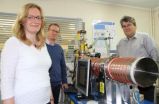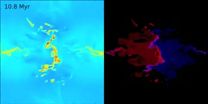(Press-News.org) New research which finds that invisible blood in urine may be an early warning sign of bladder cancer is likely to shape guidelines for clinicians.
Scientists at the University of Exeter Medical School found that one in 60 people over the age of 60 who had invisible blood in their urine (identified by their GP testing their urine) transpired to have bladder cancer. The figure was around half those who had visible blood in their urine – the best known indicator of bladder cancer. However, it was still higher than figures for other potential symptoms of bladder cancer that warrant further investigation.
Lead author Sarah Price, a PhD student at the University of Exeter Medical School, led the first robust study to investigate whether invisible blood in urine can indicate bladder cancer. Speaking as the study is published in the British Journal of General Practice on September 1 2014, she said: "It is well known that if you see blood in your urine you should contact your GP, who is likely to refer you for tests. But there is no clear guidance for GPs on what to do if they detect blood that is not visible during routine tests. We are hopeful that our findings will now lead to robust guidance that it warrants further investigation. Early diagnosis is crucial to have the best chance of successfully treating bladder cancer. The three-quarters of patients who are diagnosed early have much better outcomes than those whose disease is diagnosed late. Anything we can do to boost early detection is crucial to help save lives."
The study examined more than 26,000 people whose anonymised data contributed to the Clinical Practice Research Datalink; this is a large research database used by the Exeter team in several cancer studies. The team found that the risk of bladder cancer was 1.6 per cent in people over 60 who had invisible blood in their urine.
Around 10,000 people in the UK are diagnosed with bladder cancer each year. The condition is more common in men than women and in older people, with the average age of diagnosis at 68. Smoking is among the main causes.
INFORMATION: END
Invisible blood in urine may indicate bladder cancer
2014-09-01
ELSE PRESS RELEASES FROM THIS DATE:
Sugar substance 'kills' good HDL cholesterol, new research finds
2014-09-01
Scientists at the University of Warwick have discovered that 'good' cholesterol is turned 'bad' by a sugar-derived substance.
The substance, methylglyoxal - MG, was found to damage 'good' HDL cholesterol, which removes excess levels of bad cholesterol from the body.
Low levels of HDL, High Density Lipoprotein, are closely linked to heart disease, with increased levels of MG being common in the elderly and those with diabetes or kidney problems.
Supported by funding from the British Heart Foundation (BHF) and published in Nutrition and Diabetes, the researchers ...
New tuberculosis blood test in children is reliable and highly specific
2014-09-01
A new blood test provides a fast and accurate tool to diagnose tuberculosis in children, a new proof-of-concept study shows. The newly developed test (TAM-TB assay) is the first reliable immunodiagnostic assay to detect active tuberculosis in children. The test features excellent specificity, a similar sensitivity as culture tests in combination with speed of a blood test. The promising findings are a major advance for the diagnosis of tuberculosis in children, particularly in tuberculosis-endemic regions.
The study has been published on Sept 1st, 2014 in Lancet Infectious ...
Scientists develop 'electronic nose' for rapid detection of C. diff infection
2014-09-01
A fast-sensitive "electronic-nose" for sniffing the highly infectious bacteria C. diff, that causes diarrhoea, temperature and stomach cramps, has been developed by a team at the University of Leicester.
Using a mass spectrometer, the research team has demonstrated that it is possible to identify the unique 'smell' of C. diff which would lead to rapid diagnosis of the condition.
What is more, the Leicester team say it could be possible to identify different strains of the disease simply from their smell – a chemical fingerprint - helping medics to target the particular ...
Why plants in the office make us more productive
2014-09-01
'Green' offices with plants make staff happier and more productive than 'lean' designs stripped of greenery, new research shows.
In the first field study of its kind, published today, researchers found enriching a 'lean' office with plants could increase productivity by 15%.
The team examined the impact of 'lean' and 'green' offices on staff's perceptions of air quality, concentration, and workplace satisfaction, and monitored productivity levels over subsequent months in two large commercial offices in the UK and The Netherlands.
Lead researcher Marlon Nieuwenhuis, ...
Doctor revalidation needs to address 7 key issues for success, claims report
2014-09-01
New research launched today, 1st September 2014, has concluded that there are seven key issues that need to be addressed to ensure the future success of doctor revalidation, the most profound revision in medical regulation since the Medical Act of 1858.
The research has been funded by the Health Foundation, an independent health care charity, as part of a long-term programme looking at different aspects of revalidation. The work has been carried out by academics at the Collaboration for the Advancement of Medical Education, Research and Assessment (CAMERA) at Plymouth ...
Memory in silent neurons
2014-08-31
When we learn, we associate a sensory experience either with other stimuli or with a certain type of behaviour. The neurons in the cerebral cortex that transmit the information modify the synaptic connections that they have with the other neurons. According to a generally-accepted model of synaptic plasticity, a neuron that communicates with others of the same kind emits an electrical impulse as well as activating its synapses transiently. This electrical pulse, combined with the signal received from other neurons, acts to stimulate the synapses. How is it that some neurons ...
A new synthetic amino acid for an emerging class of drugs
2014-08-31
One of the greatest challenges in modern medicine is developing drugs that are highly effective against a target, but with minimal toxicity and side-effects to the patient. Such properties are directly related to the 3D structure of the drug molecule. Ideally, the drug should have a shape that is perfectly complementary to a disease-causing target, so that it binds it with high specificity. Publishing in Nature Chemistry, EPFL scientists have developed a synthetic amino acid that can impact the 3D structure of bioactive peptides and enhance their potency.
Peptides and ...
Discovery reveals how bacteria distinguish harmful vs. helpful viruses
2014-08-31
When they are not busy attacking us, germs go after each other. But when viruses invade bacteria, it doesn't always spell disaster for the infected microbes: Sometimes viruses actually carry helpful genes that a bacterium can harness to, say, expand its diet or better attack its own hosts.
Scientists have assumed the bacterial version of an immune system would robotically destroy anything it recognized as invading viral genes. However, new experiments at Rockefeller University have now revealed that one variety of the bacterial immune system known as the CRISPR-Cas system ...
Why sibling stars look alike: Early, fast mixing in star-birth clouds
2014-08-31
VIDEO:
This 11-second movie shows a computational simulation of a collision of two converging streams of interstellar gas, leading to collapse and formation of a star cluster at the center. Face-on...
Click here for more information.
Stars are made mostly of hydrogen and helium, but they also contain trace amounts of other elements, such as carbon, oxygen, iron, and even more exotic substances. By carefully measuring the wavelengths (colors) of light coming from a star, astronomers ...
Mixing in star-forming clouds explains why sibling stars look alike
2014-08-31
VIDEO:
This computer simulation shows the collision of two streams of interstellar gas, leading to gravitational collapse of the gas and the formation of a star cluster at the center. The...
Click here for more information.
The chemical uniformity of stars in the same cluster is the result of turbulent mixing in the clouds of gas where star formation occurs, according to a study by astrophysicists at the University of California, Santa Cruz. Their results, published August 31 in ...




